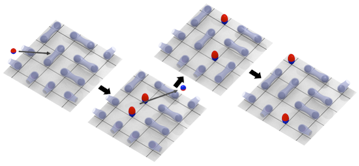Breaking the Waves – Experiments and theories on fractional excitations from 1D to 2D
 Prof. Henrik M. Rønnow 所属 : Laboratory for Quantum Magnetism (LQM), EPFL, Switzerland
Prof. Henrik M. Rønnow 所属 : Laboratory for Quantum Magnetism (LQM), EPFL, SwitzerlandNeutron Science Laboratory, ISSP, University of Tokyo, Japan
Centre for Emergent Matter Science, RIKEN, Japan
Niels Bohr Institute, University of Copenhagen, Denmark 世話人 : Minoru YAMASHITA(ext.63350), Hiroshi NOGUCHI(ext.63265)
Quantum magnets have occupied the fertile ground between many-body theory and low-temperature experiments on real materials since the early days of quantum mechanics. However, our understanding of even deceptively simple systems of interacting spin-1/2 particles is far from complete. The quantum square-lattice Heisenberg antiferromagnet, for example, exhibits a striking anomaly of hitherto unknown origin in its magnetic excitation spectrum. This quantum effect manifests itself for excitations propagating with the specific wavevector (π,0). We use polarized neutron spectroscopy to fully characterize the magnetic fluctuations in the metal-organic compound Cu(DCOO)2⋅4D2O, a known realization of the quantum square-lattice Heisenberg antiferromagnet model. Our experiments reveal an isotropic excitation continuum at the anomaly, which we analyse theoretically using Gutzwiller-projected trial wavefunctions. The excitation continuum is accounted for by the existence of spatially extended pairs of fractional S = 1/2 quasiparticles, 2D analogues of 1D spinons. Away from the anomalous wavevector, these fractional excitations are bound and form conventional magnons. Our results establish the existence of fractional quasiparticles in the high-energy spectrum of a quasi-two-dimensional antiferromagnet, even in the absence of frustration.

Illustration of fractionalization in the square lattice antiferromagnet: The electron’s magnetic moments pair up into a non-magnetic quantum entangled state called a singlet (connected pairs of blue spheres) forming a singlet sea. An incoming particle (red and blue sphere), for instance a neutron, polarize a singlet into two fractional particles called spinons (elongated red and blue spheres). Once created, the two spinons can float free of each other onto the singlet sea. [1] M. Mourigal et al., Nature physics 9, 435 (2013) ; J. Schlappa et al., Nature 485, 82 (2012)
[2] B. Dalla Piazza et al., Phys. Rev. B 85, 100508 (2012) ; M. Guarise et al., Phys. Rev. Lett. 105, 157006 (2010)
[3] N. B. Christensen et al., PNAS 104, 15264 (2007); B. Dalla Piazza et al., Nature Physics 11, 62 (2014)
【講師紹介】Ronnow先生は、スイスEPFLで研究室を主宰されており、またPaul Sherrer研究所の中性子三軸分光器の装置責任者としても活躍されています。中性子散乱を用いた量子スピン系やフラストレーション系の研究で大きな業績をあげられています。2014年12月1日から2015年3月31日まで海外客員所員として物性研に滞在される予定です。
